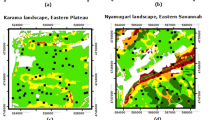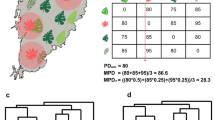Summary
Vegetation patterns were examined in three regions of coniferous forest, arrayed along a gradient of decreasing maritime influence. The following responses to decreasing maritime influence were noted: all aspects of species diversity increase; growth-form complexity increases; habitat heterogeneity increases; species habitat breadths decrease; and habitat overlaps decrease. These observations result from studies of both individual plots and data aggregated into community types. The contrasts between the maritime western study region and the more continental eastern study region imply that ecotope differentiation increases from west to east.
The enhanced structural complexity of the eastern region results from climatical limitation of the dominant tree species. Reduced canopy dominance produces greater within-habitat heterogeneity with respect to moisture, light, and soil properties. Furthermore, contrasts between the extremes of the topographic-moisture gradient increase toward the east. These factors combine to increase alpha, beta, and gamma diversities in the eastern study region above those of the western study region. Corresponding to these diversity trends are decreasing mean relative niche, habitat, and ecotope breadths of species toward the east
Similar content being viewed by others
References
Colwell R.K., & D.J. Futuyma. 1971. On the measurement of niche breadth and overlap. Ecology 52: 567–576.
Franklin, J.F., & C.T. Dyrness, 1973. Natural vegetation of Oregon and Washington, U.S.D.A. Forest Service, Gen. Tech. Report PNW-8.
Goldstein, R.A., & D.F. Grigal. 1972. Computer programs for the ordination and classification of ecosystems. Oak Ridge National Labs. IBP-71-10. 125 pp.
Grime J.P. 1977. Evidence for the existence of three primary strategies in plants and its relevance to ecological and evolutionary theory. Amer. Natur. 111: 1169–1194.
Hill M.O. 1973. Diversity and evenness: a unifying notation and its consequences. Ecology 54: 427–432.
Hitchcock C.L. & A. Cronquist. 1973. Flora of the Pacific Northwest. Univ. Washington Press, Seattle. 730 pp.
Johnson E.A. 1977. A multivariate analysis of the niches of plant populations in raised bogs. II. Niche width and overlap. Can. J. Bot. 55: 1211–1220.
Levins R. 1968. Evolution in changing environments. Princeton Univ. Press, Princeton, 120 p.
MacArthur R.H. 1965. Patterns of species diversity. Biol. Rev. 40: 510–533.
McNaughton S.J. & L.L. Wolf. 1970. Dominance and the niche in ecological systems. Science 67: 313–319.
Moral R.del. 1972. Diversity patterns in forest vegetation of the Wenatchee Mountains, Washington. Bull. Torrey Bot. Club 99: 57–64.
Moral R.del & M.F. Denton. 1977. Analysis and classification of vegetation based on family composition. Vegetatio 34: 155–165.
Moral R.del & J.N. Long. 1977. Classification of montane forest community types in the Cedar River drainage of westent Washington, U.S.A. Can. J. For. Res. 7: 217–225.
Moral R.del & L.A. Standley. 1979. Pollination of angiosperms in contrasting coniferous forests. Amer. J. Bot. 66: 26–35.
Moral R.del & A.F. Watson. 1978. Gradient structure in forest vegetation in the Central Washington Cascades. Vegetatio 38: 129–48.
Moral R.del, A.F. Watson & R.S. Fleming. 1976. Vegetation structure in the Alpine Lakes region of Washington state: classification of vegetation on granitic rocks. Syesis 9: 291–316.
Pianka E.R. 1973. The structure of lizard communities. Ann. Rev. Ecol. Syst. 4: 53–74.
Pianka E.R. 1974. Evolutionary Ecology, Harper and Row, Publishers, New York. 356 p.
Pielou E.C. 1975. Ecological diversity. John Wiley and Sons, New York. 165 pp.
Whittaker R.H. 1960. Vegetation of the Siskiyou Mountains, Oregon and California. Ecol. Monogr. 30: 278–330.
Whittaker R.H. 1977. Evolution of species diversity in land communities. Evol. Biol. 10: 1–67.
Whittaker R.H. & C.W. Fairbanks. 1958. A study of plankton copepod communities in the Columbia Basin, southeastern Washington. Ecology 39: 46–65.
Whittaker R.H., S.A. Levin & R.B. Root. 1973. Niche, habitat and ecotope. Amer. Natur. 107: 321–338.
Whittaker R.H., S.A. Levin & R.B. Root. 1975. On the reasons for distinguishing ‘niche, habitat, and ecotope’. Amer. Natur. 109: 479–482.
Zobel D.B., A. McKee, G.M. Hawks & C.T. Dyrness. 1976. Relationships of environment to composition, structure, and diversity of forest communities of the central western Cascades of Oregon. Ecol. Monogr. 46: 135–156.
Author information
Authors and Affiliations
Additional information
Nomenclature is that of Hitchcock & Cronquist (1973).
Funds for the study were provided in part by the Graduate School Research Fund, University of Washington. We thank Alan F. Watson, B.C. Cannon, S.G. Fleming, C. Brewer, K.E. Wade, K. Loughney, and M. Swanson for their able field assistance and Joan Canfield for assistance with data analysis. R.H. Whittaker, R.K. Peet, and an anonymous reviewer made valuable suggestions.
Rights and permissions
About this article
Cite this article
del Moral, R., Fleming, R.S. Structure of coniferous forest communities in Western Washington: Diversity and ecotope properties. Vegetatio 41, 143–153 (1980). https://doi.org/10.1007/BF00052443
Accepted:
Issue Date:
DOI: https://doi.org/10.1007/BF00052443




